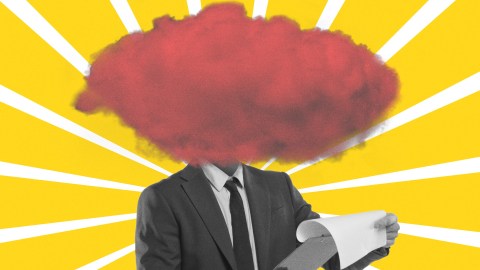What causes burnout, and how to prevent it

- Apparently, for entirely too many people, work is an unpleasant place of cynicism and despair, and something to be endured rather than a source of satisfaction or pride.
- Burnout is also not a new term. Indeed, it has been part of the popular vocabulary for the better part of a century, and perhaps even longer.
- If mismatches can be corrected or improved, then there are ways to prevent burnout and promote greater engagement with work.
In recent Gallup polls, majorities of American workers rate their jobs as mediocre or bad. Globally, the situation is even worse, with only 20 percent of employees reporting that they are engaged with their jobs. A recent study of British citizens found that, when they were working at their job, their happiness dropped around 8 percent relative to their average happiness in other life activities. The only thing they associated with more unhappiness than working was being sick in bed.
Apparently, for entirely too many people, work is an unpleasant place of cynicism and despair, and something to be endured rather than a source of satisfaction or pride. Our own research has included many conversations with a broad spectrum of workers about their workplaces. Here are comments representative of the discontent and frustration we’ve heard:
From a physician: “I gave 110 percent for many years only to find myself exhausted, bitter, and disillusioned. If I could do another profession with my medical degree, I would. I would advise my children to avoid medicine.”
From a tech worker: “I love my work. I am an avid learner and a very positive person. But I work in a socially toxic workplace. This is a highly political environment that encourages competition between colleagues, backstabbing, gossiping, and hiding information. I find going to work very difficult and I come home exhausted.”
From an engineer: “A large problem is that the company is always moving in new directions, and this is done in secret without receiving input from the professionals who actually perform the jobs. It makes us feel devalued when changes are made to a department or program, but the staff is never consulted or asked what could be done to improve their job.”
There is a paradox here. Organizations’ ideals and employees’ experiences are disconnected, even at odds with one another. At a time when leaders extol the virtues of respectful workplaces and engaging teamwork, complaints of incivility, abuse, and bullying run rampant. Even as consultants and managers incessantly beat the drum of engagement, dissatisfaction remains an intense concern, including in the professions offering the greatest possibilities for vibrant, dedicated, absorbing work. Everywhere, there are thoughtful leaders deeply concerned with helping their employees be productive, fulfilled, and healthy — and there is proof that some of what they do makes a difference. But the evidence also shows that, all too often, their efforts fall short of the mark.
Various social, political, and economic factors have shaped the work environment such that many jobs are increasingly stressful. Competitive pressures to cut costs and increase profits have resulted in downsizing, for example, leaving smaller staffs to manage the same workloads. In some sectors, changing public policies — and in health care, the rise of managed care — have strongly affected what customer-facing workers can provide and what they cannot. For many kinds of work, real wages have declined, and job benefits have been cut back. The result is a fundamental contradiction in the workplaces of the twenty-first century. On the one hand, organizations increasingly need the creativity and involvement of their employees. On the other hand, organizations have made changes that undermine people’s capacity to be engaged in their work.
The negative impact of these workplace trends creates an employee experience of a crushing exhaustion, feelings of cynicism and alienation, and a sense of ineffectiveness — the triumvirate known as burnout. The burnout syndrome occurs when people experience combined crises on all three of these dimensions, most of the time. They feel chronically exhausted; they have withdrawn mentally, socially, and emotionally from their work; and they have lost confidence in their capacity to have a constructive impact. Basically, this means that they are experiencing high stress, a hostile job environment, and a pessimistic evaluation of themselves. Burnout is an apt term, suggesting a once-hot fire that has been reduced to ashes: those ashes are the feelings of exhaustion and a lack of engagement left after an initial, internal flame of dedication and passion is extinguished. The accelerants are the workplace conditions creating too-hot environments and leaving behind this trifecta with its scorching effects on people’s lives.
Burnout is also not a new term. Indeed, it has been part of the popular vocabulary for the better part of a century, and perhaps even longer. (Google’s Ngram viewer charts its rise from a starting point in the 1820s.) The concept of the human stress response to difficult life events (stressors) was developed in the 1950s. Before then, burnout (or burn-out) was most commonly used in engineering to describe the result when repetitive stress or excessive load on a piece of equipment ruins its ability to function (as when a motor, or light bulb, or rocket booster burns out). Perhaps the engineering use of the term was why its application to workplaces took off in Silicon Valley, where early start-up ventures were referred to as “burnout shops.” But burnout also became a slang word for a chronic drug abuser, and resonated with the idea of “burning the candle at both ends.” Graham Greene called his 1961 novel about an architect in a state of spiritual crisis and disillusionment A Burnt-Out Case.
By the 1970s, workers in various realms of health and human services were using burnout to describe their own job crisis. One of us (Maslach), conducting interviews with such workers for a research project, heard the term repeatedly along with the stories behind it—and soon shifted the project to focus on burnout instead.6 She collaborated with Susan Jackson in 1981 to publish the Maslach Burnout Inventory (MBI), an instrument for assessing the experience. Then the two of us (Leiter and Maslach) joined forces on three lines of work: developing additional versions of that measurement tool, and a new one, the Areas of Worklife Survey (AWS); con ducting research studies on burnout along with international colleagues; and writing our first book on burnout. Since the latter came out in 1997, we have conducted studies in numerous organizations, tracking the development of job burnout, finding ways of reversing it, and nudging people toward engagement instead. Clearly, understanding burnout has been a major focus of our lives’ work. In this book, we pull all of it together into an integrated perspective on burnout and what to do about it.
In 2019, the World Health Organization (WHO) recognized burnout as a legitimate occupational phenomenon that could have a negative impact on the well-being of workers in the workplace. In its words:
Burn-out is a syndrome conceptualized as resulting from chronic workplace stress that has not been successfully managed. It is characterized by three dimensions:
• feelings of energy depletion, or exhaustion.
• increased mental distance from one’s job, or feelings of negativism or cynicism related to one’s job.
• reduced professional efficacy.
The year after WHO recognized burnout as a legitimate occupational phenomenon, the coronavirus disease — abbreviated as Covid-19 — forced the closure of many workplaces, including offices, schools, restaurants, food-processing facilities, and more. Starting in early 2020, the pandemic caused many people to experience dramatic changes in their job, often with no warning or preparation — just think of the healthcare workers whose workload increased with the onslaught of Covid patients, or the teachers suddenly educating students online rather than in person. Other people had to deal with the uncertainty of cutbacks in their organizations, and risks of losing their jobs entirely.
We already knew that, when workplaces are designed mostly for the economic bottom line, they may miss the mark on the human one, and that they can actually be bad for the people who work within them. Many decades of research on various risk factors in the workplace (such as high demands, toxic hazards, job insecurity, lack of control, and so on) have shown that unhealthy job environments harm employees both physically and mentally, with ultimate damage to the economic bottom line. The pandemic added even more risk factors to this equation — such as working too close to other people, for longer hours, in enclosed spaces.
During the pandemic people were using the term burned out colloquially to describe feeling stressed. Doing so does not question burnout’s research-based definition, any more than people saying colloquially that they are depressed challenges the reality that depression is a clinically diagnosable condition. But it was in the midst of this challenging time that we felt, more than ever, that we needed to share a deeper understanding of burnout and how to combat it, based on decades of research and analysis of data.
We believe burnout arises from the increasing mismatch between workers and workplaces. As the WHO definition explains, the occupational phenomenon of burnout is the result when chronic workplace stressors have “not been successfully managed.” If conditions and requirements set by a workplace are out of sync with the needs of people who work there, this bad fit in the person–job relationship will cause both to suffer. Our research has identified at least six forms of mismatch that can exist between a job and the person holding it:
• work overload
• lack of control
• insufficient rewards
• breakdown of community
• absence of fairness
• value conflicts
Poor alignment in any one of these six areas increases the risk of burnout. For example, let’s consider work overload. If job demands cannot be met within the usual workday, then employees have to work extra hours and take time away from other important parts of their lives (such as personal interests, family and friends, and sleep). We’ve found that these bad mismatches often have their roots in erroneous assumptions about what makes people tick — what motivates them, what rewards them, and what discourages them. In other words, there is often a misunderstanding of basic psychology. The more that any or all of these six conditions depart from employees’ aspirations or preferred ways of working, the more they are vulnerable to burnout.
In the chapters that follow we detail these six mismatches — what they are, why they have such a toxic effect, and how to fix them and achieve better matches between the job and the person. If mismatches can be corrected or improved, then there are ways to prevent burnout and promote greater engagement with work.
The analogy we began with of the canary in the coal mine is an apt one for understanding the burnout experience, because it focuses our attention on three critical things: the individual, the context, and the relationship between them. If the individual canary is noticeably suffering within the context of the mine, it is a red-flag warning that the context has problems — that will affect not only the canary, but any other individuals working there. One could say that the relationship between the canary and the coal mine represents a serious mismatch between the individual (with its need for oxygen) and the workplace (with its carbon monoxide–filled air). What can be done, for the individual and the workplace, to fix the relationship between them, so that work can be done safely? The answers lie in the pages to follow.





